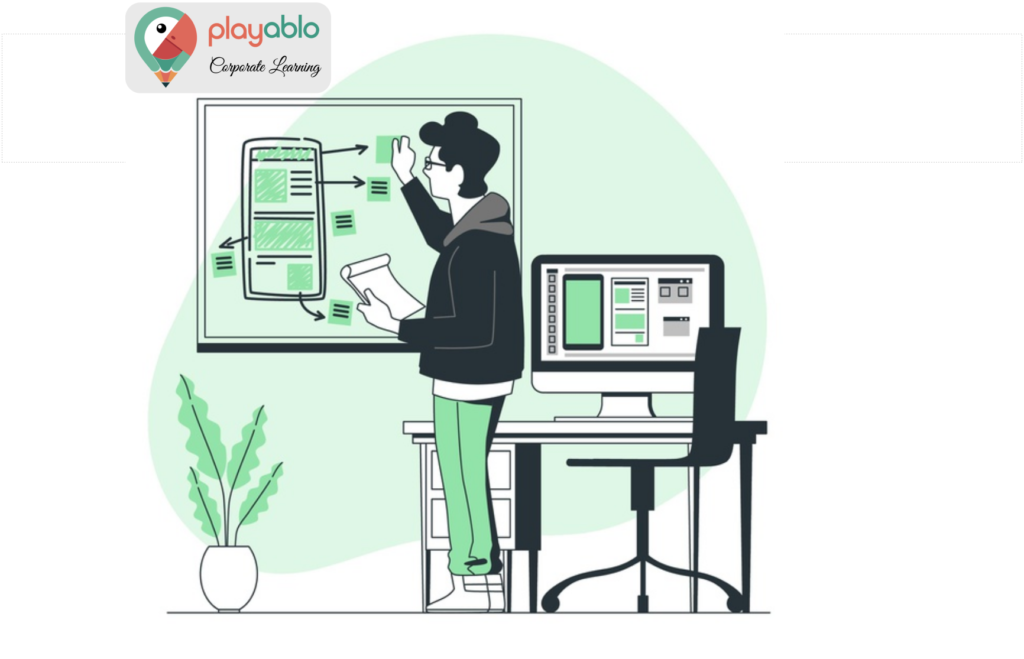Why should you focus to improve LMS adoption? Well, “A mind needs books, as a sword needs a whetstone if it is to keep its edge” – Tyrion Lannister, Game of Thrones. As we have constantly reiterated, learning is not a one-time process. It is a continuous curve. One needs to sharpen their skills to become proficient in it continually. After all, practice makes perfect, and that’s the primary importance of training!
This same concept is also applicable in corporate eLearning. In L&D, the leadership needs to ensure that they create a culture of learning within the organization. Now, your next question may be: What is the importance of training? How do you start a full-fledged learning culture in your company? Well, the first step is to identify the learning gaps in your organization and then think of a comprehensive Learning Management System (LMS) to address your requirements.

So, is that it? No, of course not! When you launch an LMS, you must ensure that your employees are involved in its integration. And this process starts from the beginning. You MUST make sure that your workforce knows how to use an LMS and thoroughly learn from it. Only then you can unleash its full potential.
According to Brandon Hall Group’s LMS study: ‘LMS Trends: Installed vs SaaS Deployment‘, “Poor usability, mobile incompatibility, and out-of-date appearance are the top reasons for user dissatisfaction.” Hence, simply introducing new software in your corporate training methodology does not solve your problems. You MUST ascertain that your employees are engaged with technology and truly comprehend the importance of training. Well, our tried and tested tips might help improve LMS adoption rates in your company.
Table of Contents
How to Improve LMS Adoption Rates in Corporates

Effective utilization of any enterprise software hinges on user adoption. In the realm of L&D, the weakest link in the eLearning chain often lies in the adoption of Learning Management Systems.
Despite investing significant time, effort, and resources in selecting, gaining internal support for, procuring, implementing, and training administrators and users on an LMS, its success ultimately depends on whether users embrace it. If they don’t or, worse, dislike using it, all those efforts go to waste. In such cases, instead of forcing adoption, organizations often go back to square one, searching for an alternative solution.
So, what’s the way forward? It starts with recognizing that user adoption is paramount right from the beginning. Remember, if your learners don’t engage with your solution, it’s doomed from the start.
With this in mind, we’ve compiled 3 key areas you MUST focus on to ensure a successful user adoption journey:
How to Increase LMS Engagement: 3 Critical Aspects to Consider
The three prime elements you need to prioritize when aiming to enhance your LMS user adoption rates are:
- Design and UX
- Integration
- Change Management
Let’s now break them down for you:
The Design and UX Aspect

Your UX includes the user interface (UI) — the overall appearance of the LMS, its navigation features, tagging, and more. If you have a poor and complicated UX, learners will drop out soon after enrolling in a course. The aforementioned study by Brandon Hall Group states that “50% of learners identify poor user experience as one of the biggest obstacles to reaching satisfaction with learning technology. In fact, 88% of organizations switch LMSs because of bad UX.”
Again, the design matters. A mobile-friendly and responsive user interface motivates your learners to adopt any new technology and to improve LMS online adoption — fast! The modern, fast-paced millennial employee prefers knowledge that can be absorbed on the go in bite-sized chunks. They opt for learning models and a corporate training methodology — that allow them to learn at their own pace when they have free time — during their commute hours or between multiple tasks.
Research suggests that “33% of smartphone owners opt to use mobile phones for surfing.” Therefore, by going for a mobile-friendly LMS design, you can reap the maximum benefits from this trend.
Ad: PlayAblo’s Enterprise-Grade Micro-Learning platform is built for millennial learners. Micro-learning, along with assessments and gamification features, ensures learning outcome measurement along with sustained engagement.
Find out more and request a custom demo!
Again, to improve LMS adoption, the LMS design should offer a seamless experience.
Smooth Navigation
Learners should be able to see the required features as soon as they sign in. If they have to spend long hours just locating a course module, they will get frustrated and drop out. The bottom line? Your UX design should be intuitive, responsive, and simple — to improve LMS adoption.
Striking Appearance
Finally, to improve LMS adoption, ensure your enterprise LMS is pleasing to the eye. You can customize the appearance of your platform so that it appeals to users and entices them to access it more. Eye-grabbing, exciting content, illustrated examples like graphs and charts, and video clips are a few ways to up the engagement quotient of your LMS.
Also, gamification elements embedded in the technology — points systems, leaderboards, and badges — play a significant role in increasing user engagement and helping them understand the importance of training.
Ad: PlayAblo’s Enterprise-Grade Micro-Learning platform is built for millennial learners. Micro-Learning, along with assessments and gamification features, ensures learning outcome measurement along with sustained engagement.
Find out more and request a custom demo!
The Integration Aspect

Organizations can adapt and improve LMS adoption rates faster when the new software can be effortlessly integrated into the existing one. You should pick an LMS, which has at least a few elements that have similarities with those currently in place. A sense of familiarity also infuses employees to relate to the new technology, increasing their engagement and understanding levels about the importance of training.
However, blending with an existing technology does not mean that the designs must also match. The branding has to be consistent but not the overall design.
Standardized Language
You can address the integration aspect by standardizing the language and terminology. If you use terms that employees use during their regular conversations, you will make your course modules easier to understand. Again, consistent branding, coupled with known scenarios and real-life examples, renders the training practically applicable and relatable.
Customization As Per User Challenges
Additionally, when introducing the new LMS, ensure that it offers advantages that the earlier one did not — to improve LMS adoption rates. Your employees will then appreciate your efforts to address their pain and gap areas. After all, Forbes has suggested that “Learning and development opportunities are listed among the top 10 factors in workplace satisfaction.”
The Change Management Aspect

To improve LMS adoption rates, you have to follow an end-to-end process. This comes with both technical and psychological changes. The success of your LMS will largely depend on the targeted demography and mental prowess of your workforce.
Roger’s Bell Curve
While some people are more receptive to change, others are less open. Roger’s Bell Curve segments the technology adoption curve as follows:
- The innovators who are immensely receptive to new ideas and technologies
- The early adopters who are open to fresh innovations
- The early majority who are comparatively conservative but still open to new ideas
- The late majority who are fairly conservative and less receptive to new technologies
- The laggards who are extremely conservative
Keeping the above model in mind, you need to aim for a high-quality, consistent change management program that ensures high employee satisfaction and better compliance with new practices in order to improve LMS adoption rates and help people comprehend the importance of training.
Kotter’s 8-Step Process for Leading Change
You can enforce this by following Kotter’s 8-Step Process for Leading Change:
- CREATE A SENSE OF URGENCY – So that others can see change as an opportunity needing immediate implementation.
- BUILD A GUIDING COALITION – A volunteer army needs a coalition of influential people, born of its ranks, to guide it, coordinate it, and communicate its activities.
- FORM A STRATEGIC VISION AND INITIATIVES – Explain how the future will drastically transform after deploying the initiatives linked directly to the vision.
- ENLIST A VOLUNTEER ARMY – To rally around a shared opportunity.
- ENABLE ACTION BY REMOVING BARRIERS – Eliminate obstacles like obsolete processes and hierarchies, so that working in silos becomes history.
- GENERATE SHORT-TERM WINS – Recognize, collect, and communicate wins to track progress and energize volunteers to persist.
- SUSTAIN ACCELERATION – After the first successes, push harder to improve systems, structures, and policies.
- INSTITUTE CHANGE – Interlink new behaviors and organizational success until they replace old habits
Patient and careful focus on the overall design, implementation, and change management can improve LMS adoption rates. When you pay the required attention to the needs and demands of your workforce, you boost the chances of employees happily and willingly adopting a new LMS.
Wrapping It Up
Effective learning and development are vital for an organization’s growth and success. An LMS platform is a key tool for achieving the key objectives of your various types of corporate training. However, adopting this technology is just the beginning. Ensuring employee acceptance of the LMS, often more challenging, is equally crucial.
Implement smart strategies to promote the LMS organization-wide. This fosters engagement, contributes to a learning culture, and boosts employee performance, retention, and overall organizational success.
If you need guidance or leadership for your LMS implementation or assistance with your learning and development strategy, including an engaging corporate training methodology, contact PlayAblo today. We’re here to help.
Ad: PlayAblo’s Enterprise-Grade Micro-Learning LMS platform is built for millennial learners. Micro-learning, along with assessments and gamification features, ensures learning outcome measurement along with sustained engagement.
Find out more and request a custom demo!







1 Comment